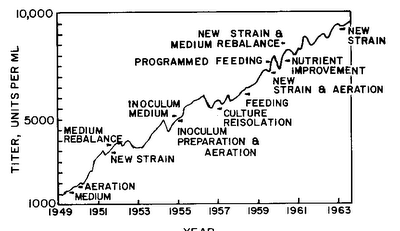Assays for compounds that make existing antibiotics effective against antibiotic resistant bacteria.
 The figure above shows structures of the beta-lactam semi-synthetic antibiotic amoxycillin (top) and the different compound clavulanate (lower). These two compounds are used together as a powerful synergistic antibacterial combination therapy in current medical treatments. Although amoxycillin is a semi-synthetic penicillin, clavulanate is not even an antibiotic, but an inhibitor of the bacterial enzyme beta-lactamase, which is enzyme which makes many bacteria resistant to penicillins and the related cephalosporins. Clavulanate is thus augments or extends the effectiveness of beta-lactam antibiotics, and it is produced naturally by a soil Streptomycete. Note that amoxycillin has a side chain (with a phenol group) and the beta-lactam bicyclic ring system which includes N and S atoms. (Image from Sandoz.Com.)
The figure above shows structures of the beta-lactam semi-synthetic antibiotic amoxycillin (top) and the different compound clavulanate (lower). These two compounds are used together as a powerful synergistic antibacterial combination therapy in current medical treatments. Although amoxycillin is a semi-synthetic penicillin, clavulanate is not even an antibiotic, but an inhibitor of the bacterial enzyme beta-lactamase, which is enzyme which makes many bacteria resistant to penicillins and the related cephalosporins. Clavulanate is thus augments or extends the effectiveness of beta-lactam antibiotics, and it is produced naturally by a soil Streptomycete. Note that amoxycillin has a side chain (with a phenol group) and the beta-lactam bicyclic ring system which includes N and S atoms. (Image from Sandoz.Com.)The useful beta lactamase inhibitor clavulanate was discovered around 1970 using a clever but simple assay strategy.
It required a simple way of measuring inhibition of beta lactamase enzyme activity.
Thus the biological activity being sought was inhibition of enzyme catalysis.
For this another beta-lactam antibiotic, Nitrocefin, was most useful. This antibiotic is pretty useless in treating infection as it may cause cancer and many bacteria are resistant to it. But it is superb for detecting chemicals that inhibit beta-lactamases, such as clavulanate.
This is because it changes from yellow to red colour when exposed to beta-lactamase.
The diagram below illustrated how on overlay of soft agar containing a freshly made mixture of Nitrocefin plus beta-lactamase enzyme can reveal beta-lactamase inhibitors diffusing from a bacterial colony. the diagram shows schematically the cross section of petric dish culture on which an unknown type of soil bacteria have developed as a colony.
 The most practically useful part of this strategy is that it can be cheaply and conveniently adapted to screen hundreds of thousands of novel bacterial isolates. It does this without demanding much expensive labour.
The most practically useful part of this strategy is that it can be cheaply and conveniently adapted to screen hundreds of thousands of novel bacterial isolates. It does this without demanding much expensive labour.It is thus a cheap high through-put assay or screen.
This approach enabled a drug company to find soil microbes that produce then unknown biological activities of beta-lactamase inhibition in the 1970s. These activities included clavulanate. Late work by chemists led to other antibiotic extenders such as sulbactam and tazobactam being synthesised.
Further reading:
Link on Nitrocefin colour changes
More ambitious microtitre dish assays based on this idea.
Labels: Discovery



